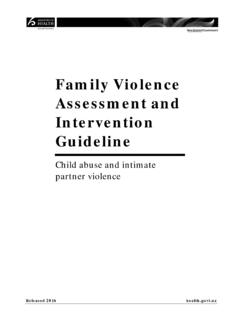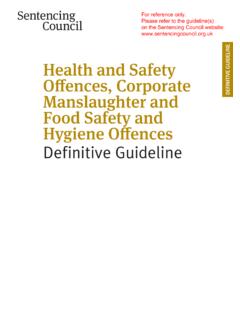Transcription of Guideline on good pharmacovigilance practices (GVP)
1 9 October 2017 2017. EMA/118465/2012 Rev 1*. Guideline on good pharmacovigilance practices (GVP). Module XV safety communication (Rev 1). Date for coming into effect of first version 24 January 2013. Draft Revision 1* finalised by the Agency in collaboration with Member States 17 November 2015. Draft Revision 1 agreed by the European Risk Management Facilitation Group 24 November 2015. (ERMS FG). Draft Revision 1 adopted by Executive Director 8 December 2015. Release for consultation 15 December 2015. End of consultation (deadline for comments) 29 February 2016.
2 Revised draft Revision 1 finalised by the Agency in collaboration with Member 27 September 2017. States Revised draft Revision 1 agreed by the EU Network pharmacovigilance 4 October 2017. Oversight Group (EU-POG). Revised draft Revision 1 adopted by Executive Director as final 9 October 2017. Date for coming into effect of Revision 1* 13 October 2017. *Note: Revision 1 contains the following: - Introduction of the concept of core EU DHPC for situations where a common DHPC prepared at EU. level may not be appropriate because of different requirements at the level of Member States ( differences in available alternative treatments) and the PRAC/CHMP therefore agrees on core messages only (changes in , , and ).
3 - Introduction of the option that one marketing authorisation holder may act on behalf of other marketing authorisation holders with a goal of disseminating one single DHPC in situations where several marketing authorisation holders are concerned (changes in );. - Adjustments of references to other GVP Modules, given the recently revised GVP structure (see page 6 of GVP Introductory Note of 15 December 2015);. - Editorial improvements throughout the Module (changes in particular in , , , , , , , , , );. See websites for contact details European Medicines Agency The European Medicines Agency is Heads of Medicines Agencies an agency of the European Union European Medicines Agency and Heads of Medicines Agencies, 2017.
4 Reproduction is authorised provided the source is acknowledged. - The revised GVP Annex II DHPC template (EMA/36988/2013) and the new GVP Annex II DHPC. Communication Plan template (EMA/334164/2015) have been replicated at the end of the Module for ease of reference;. - After the public consultation, the outcome of work package 2 on communication and dissemination of the Strengthening Collaboration for Operating pharmacovigilance in Europe (SCOPE) Joint Action of the Member States (see ) have become available and have been incorporated to the Module.
5 Guideline on good pharmacovigilance practices (GVP) Module XV (Rev 1). EMA/118465/2012 Rev 1 Page 2/20. Table of contents Introduction .. 4. Structures and processes .. 5. Objectives of safety communication .. 5. Principles of safety communication .. 5. Target audiences .. 6. Content of safety communication .. 6. Means of safety 7. Direct healthcare professional communication (DHPC) .. 7. Communication materials from competent authorities targeted at healthcare professionals .. 8. Documents in lay language to patients and the general public.
6 8. Press communication .. 9. Website .. 9. Social media and other online communications .. 10. Bulletins and newsletters .. 10. Inter-authority communication .. 10. Responding to enquiries from the public .. 10. Other means of communication .. 10. Effectiveness of safety communication .. 10. Quality system requirements for safety communication .. 11. Operation of the EU regulatory network .. 11. Coordination of safety announcements in the EU .. 11. Process for exchange and coordination of safety announcements .. 12. Exchange of safety information produced by third parties.
7 13. Requirements for the marketing authorisation holder in the EU .. 13. Consideration for third parties .. 13. Languages and translations .. 14. Direct healthcare professional communications (DHPCs) in the EU .. 14. Processing of DHPCs .. 14. Translation and dissemination of DHPCs .. 15. Publication of DHPCs .. 16. Figure : Flow chart for the processing of Direct Healthcare Professional Communications (DHPCs) in the EU .. 17. GVP Annex II Templates: Direct Healthcare Professional Communication .. 18. GVP Annex II Templates: Communication Plan for Direct Healthcare Professional Communication.
8 20. Guideline on good pharmacovigilance practices (GVP) Module XV (Rev 1). EMA/118465/2012 Rev 1 Page 3/20. Introduction This Module provides guidance to marketing authorisation holders, competent authorities in Member States and the European Medicines Agency on how to communicate and coordinate safety information concerning medicinal products authorised in the EU. Communicating safety information to patients and healthcare professionals is a public health responsibility and is essential for achieving the objectives of pharmacovigilance in terms of promoting the rational, safe and effective use of medicines, preventing harm from adverse reactions, minimising risks and contributing to the protection of patients' and public health (see GVP Module I).
9 safety communication is a broad term covering different types of information on medicines, including statutory information as contained in the product information ( the summary of product characteristics (SmPC), package leaflet (PL) and the labelling of the packaging) and public assessment reports. Although some principles in this Module ( and ) apply to all types of safety communication, the Module itself focuses on the communication of important new safety information', which means new information about a previously known or unknown risk of a medicine which has or could have an impact on a medicine's risk-benefit balance and its condition of use.
10 Unless otherwise stated, the term safety communication' in this Module should be read as referring to new safety information. Experience so far has demonstrated the need to coordinate safety communication within the EU. regulatory network. High levels of public interest are anticipated when new safety concerns arise and it is important that clear and consistent messages are provided across the EU in a timely manner. The new legislation on pharmacovigilance therefore includes a number of provisions to strengthen safety communication and its coordination 1.
















